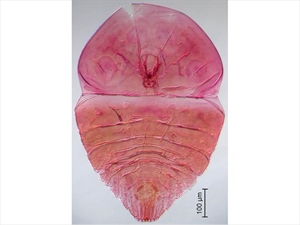Cashew scale. It is also known as the trilobite scale.
Pacific Pests, Pathogens and Weeds - Online edition
Pacific Pests, Pathogens & Weeds
Cashew scale (383)
Pseudaonidia trilobitiformis. It was previously recorded as an Aspidiotus species, and as Pseudaonidia darutyi. [Note, a definitive identification of the scale on citrus from Fiji is awaited. The scale was provisionally identified using photos on orange. It is more usually found on leaves.]
Asia, Africa, North, South and Central America, the Caribbean, Europe, Oceania. It is recorded from Australia, Fiji, French Polynesia, New Caledonia, and Vanuatu.
The host range is very wide. It has been recorded on more than 45 plant families. Barringtonia, capsicum, chilli, citrus (many species), coconut, coffee, Ficus (many species), frangipani, mango, woody legumes are hosts, but there are others.
Leaves and more rarely fruits are infested (Photos 1&2). The scale cover of the female is semi-circular, 2.5-3 mm diameter, domed, yellowish-brown, with the side adjacent to the leaf midrib flattened. The remains of the first moult is red-brown, off-centre and clearly visible. The exposed body of the female is wine-red (Photo 3). The male is oval, 1.8mm long, dirty white.
Crawlers are the primary dispersal stage and move to new areas of the plant or are dispersed by wind or animal contact. Mortality due to abiotic factors is high in this stage. Dispersal of eggs, 'crawlers' (nymphs), and adults through transport of infested plant material.
The scale is known as an important pest of cashew, citrus and cocoa.
Look for sub-circular pale or yellow-brown scale covers, each with dark red-brown central or sub-central area, the remains of the original scale.
NATURAL ENEMIES
The parasitic wasp, Habrolepis neocaledonensis, has been recorded in New Caledonia, and the predator ladybird beetle (Coccinellid), Rhyzobius pulchellus, attacks nymphs and adults in Vanuatu and New Caledonia.
CHEMICAL CONTROL
Crawlers are more susceptible to insecticides than other stages, but they are very small and difficult to see. There are also overlapping generations, so adults are always present, and this means that several applications of chemicals are necessary to obtain control. Adults are difficult to kill because of their protective scales. (Note dimethoate, once recommended in Pacific island countries, is under suspension in Australia for use on many crops.)
- Use lime sulphur (polysulphide sulphur) or wettable sulphur (fine form of elemental sulphur which is soluble); leave at least 30 days between spraying lime sulphur and sprays of oil. Take care to follow manufactures' instructions as sulphur can burn the leaves. Note applications of sulphur will most likely kill parasitoid wasps. If you are not sure of the sensitivity of the foliage to sulphur, test a free shoots/branches before spraying the entire shrub or tree.
- Alternatively, use white oil (made from vegetable oils), soap solution, or horticultural oil (made from petroleum) (see Fact Sheet no. 56). Often the damage occurs in patches on the trees, so consider just spot-spraying those areas where infestations occur, rather than the whole tree.
- White oil:
- 3 tablespoons (1/3 cup) cooking oil in 4 litres water.
- ½ teaspoon detergent soap.
- Shake well and use
- Soap:
- Use soap (pure soap, not detergent).
- 5 tablespoons of soap in 4 litres water, OR
- 2 tablespoons of dish washing liquid in 4 litres water.
- Commercial horticultural oil can also be used. White oil, soap and horticultural oil sprays work by blocking the breathing holes of insects causing suffocation and death. Spray the undersides of leaves; the oils must contact the insects. A second application of soap or oils may be necessary after 3-4 weeks.
- The addition of malathion is useful against scales insects, but it is likely to kill natural enemies.
- Synthetic pyrethroid insecticides are likely to be effective against the crawlers - crawlers are the active nymphs that spread infestations, but they are difficult to see as they are so small. However, synthetic pyrethroids are likely to kill natural enemies, and should be avoided if possible.
- White oil:
____________________
When using a pesticide, always wear protective clothing and follow the instructions on the product label, such as dosage, timing of application, and pre-harvest interval. Recommendations will vary with the crop and system of cultivation. Expert advice on the most appropriate pesticides to use should always be sought from local agricultural authorities.
AUTHORS Grahame Jackson & Mani Mua
Information from Diaspididae of the World 2.0 Pseudaonidia trilobitiformis. (https://diaspididae.linnaeus.naturalis.nl/linnaeus_ng/app/views/species/nsr_taxon.php?id=113125&cat=TAB_DESCRIPTION&epi=155); and from Garcia Morales G et al. (2016) ScaleNet: A literature-based model of scale insect biology and systematics. Database. (http://scalenet.info/catalogue/Pseudaonidia%20trilobitiformis/). Photo 3 MAF Plant Health & Environment Laboratory (2011) Trilobite Scale (Pseudaonidia trilobitiformis): PaDIL - (http://www.padil.gov.au).
Produced with support from the Australian Centre for International Agricultural Research under project HORT/2016/18: Responding to emerging pest and disease threats to horticulture in the Pacific islands, implemented by the University of Queensland and the Pacific Community.






